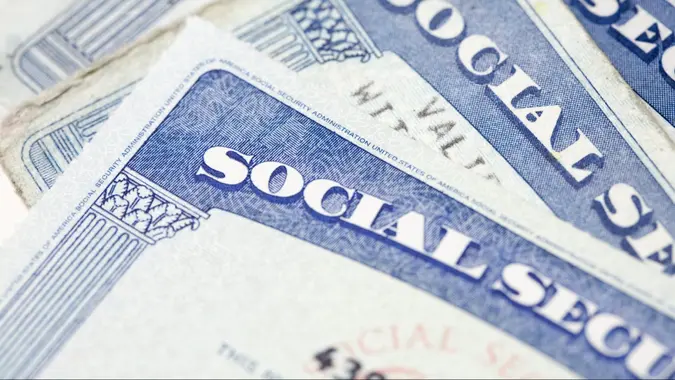What To Know About Social Security If You’re in Your 60s

Commitment to Our Readers
GOBankingRates' editorial team is committed to bringing you unbiased reviews and information. We use data-driven methodologies to evaluate financial products and services - our reviews and ratings are not influenced by advertisers. You can read more about our editorial guidelines and our products and services review methodology.

20 Years
Helping You Live Richer

Reviewed
by Experts

Trusted by
Millions of Readers
Once you’re in your 60s, Social Security is literally right around the corner. Whether you claim as early as possible, at age 62, or wait as long as you can, until age 70, your choices will have far-reaching ramifications for your retirement security.
You won’t have much time to boost your Social Security earnings by the time you reach your 60s, but there are still ways to maximize the amount you’ll earn. It’s also the perfect time to learn the ins and outs of how Social Security operates to ensure you don’t make costly mistakes.
What’s the Difference Between Claiming Early and Claiming Late?
You can file for Social Security retirement benefits as early as age 62, but your monthly benefit will be permanently reduced by 30%. This means if your expected benefit at full retirement age of 67 is $1,500, you’ll receive just $1,050 per month if you start at age 62.
There are pros and cons to the strategy of claiming benefits early. The obvious con is that you’ll be receiving, in this example, $450 less per month for the rest of your life. That amounts to a reduction of $5,400 per year, not accounting for annual cost-of-living adjustments.
On the plus side, however, is that you would receive an additional 60 payments, or 12 per year, from ages 62 to 67. Those payments alone would total $63,000, again not taking into account any annual cost-of-living adjustments.
Filing at age 70 also has its pros and cons. Benefits increase by 8% per year that you wait to file between full retirement age of 67 and the last allowable age of 70. This means if your standard full retirement benefit is $1,500, you could boost that monthly payout to $1,860 if you wait to claim until age 70. That amounts to an additional $4,320 annually (again, not taking into account COLAs). It also translates to an additional $810 per month vs. claiming at age 62, or close to $10,000 per year.
The bottom line is that the difference between filing at age 62, 67 and 70 can be monumental.
Should I File at Age 62, Age 70 or Somewhere In Between?
Whether you should choose to file for Social Security early or late is a constant debate. The problem lies in the uncertainty of the future.
If you know you’re going to live a long and healthy life, claiming late may be the best answer, as you’ll have an elevated payout for decades. But if you’re in poor health and you have a history of family medical problems, you may not live to see those increased payments, in which case filing early makes sense.
Some taxpayers simply want their money as fast as they can get it, or they don’t believe in the long-term viability of the Social Security system, so they claim as early as possible. It pays to sit with your tax and financial advisors, and perhaps even your medical professionals, to help determine the best path for you.
How To Claim Benefits
Claiming benefits is actually fairly straightforward. Simply log on to the Social Security Administration website and provide all of the requested documentation. The SSA prefers that retirees file this way, although you also can visit a local SSA branch or give them a call at (800) 772-1213.
Essentially, you’ll just need to provide identifying documents about yourself and your employment. Expect to provide your Social Security number, birth certificate and a copy of your most recent W-2 or self-employment tax return.
You’ll also need to provide information about any unmarried children under 18 (age 18-19 if in school or age 22 if disabled), your bank information and citizenship status. If necessary, the SSA will contact you for additional information.
How Far in Advance Do I Need To File for Social Security?
You can file for your retirement benefits as much as four months in advance. This means if you turn age 62 in November and want your benefits to begin then, you can file as early as September.
Will Your Benefits Be Taxable?
Whether or not your Social Security benefits are taxable depends on how much outside income you earn. The tax rate on your benefits will be 0%, 50% or 85% depending on your earnings. Here’s the income breakdown for tax year 2022:
- For single filers: 0% below $25,000, 50% between $25,000 and $34,000, 85% for earnings above $34,000
- For joint filers: 0% below $32,000, 50% between $32,000 and $44,000, 85% for earnings above $44,000
These brackets may play a role in how much income you want to earn from a side gig in retirement.
What Are the Average and Maximum Benefits?
In 2023, the average Social Security retirement benefit is $1,827. The maximum benefit is $4,555.
The maximum benefit is difficult to achieve, as it requires 35 years of earning at the top of the Social Security wage base and then waiting to claim at age 70.
You can verify your own estimated benefits at ages 62, 67 and 70 by creating a “my Social Security” account at ssa.gov.
 Written by
Written by  Edited by
Edited by 























